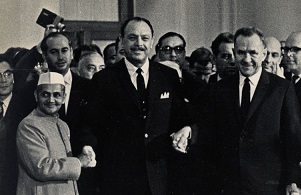On 10th January 1966, the Tashkent Declaration was signed between India and Pakistan following the inconclusive war of 1965. This article will give details about the historic declaration within the context of the IAS Exam.
| To know more about the general pattern of the UPSC History segment, be sure to visit the UPSC History Syllabus page now!!
To complement your preparation in the History segment of the UPSC exams, check the following links: |
What was the Tashkent Declaration?
The Tashkent Declaration was a peace agreement signed between India and Pakistan to resolve the Indo-Pakistan war of 1965 (August 5, 1965 – September 23rd 1965). It was signed at Tashkent, capital of Uzbekistan which in turn was a part of one of the republics that comprised of the USSR. The main aim was to restore economic and diplomatic relationships in the respective countries and to keep away from each other’s internal and external affairs, and to work towards the progress of bilateral relations.
Background
The first Indo-Pakistani war also known as the First Kashmir War (22 October 1947 – 5 January 1949) was fought just after the independence of India and Pakistan. A ceasefire agreement led to the establishment of the Line of Control (LOC) as the de facto border between India and Pakistan in Kashmir.

In April 1965, Pakistan sent its special forces unit dressed as Kashmiri locals, marking the start of Operation Gibraltar/ The aim of the operation was to capture Kashmir by fomenting an insurrection against the Government of India by the local populace.
The operation was a failure due to the local population informing the Indian Army on time. This led to an all-out war in August 1965. It continued until September of that year, threatening to draw in two major superpowers of the Cold War-era- the United States and the USSR.
To their credit, both the superpowers used every diplomatic means to bring the two warring nations to the negotiation table. In the end, both India and Pakistan agreed to cease all hostilities after a United Nations Security Council resolution calling for the end of the war was passed on 22nd September 1965
The mediation was done through the USSR, upon which a meeting was held at Tashkent, from 4th to 10th January 1966 in order to create a more lasting peace between India and Pakistan. The discussion was between Indian Prime Minister Lal Bahadur Shastri, Pakistani President Muhammad Ayub Khan being moderated by Soviet Premier Alexei Kosygin
Tashkent Declaration – Salient Points
- According to the Declaration, the following points were to be followed by both countries:
- India and Pakistan would both fall back to their previous positions held prior to August 5 1965
- Neither would interfere in the internal affairs of the others and would discourage toxic propaganda against each other
- There would be an orderly transfer of prisoners of war, and the two leaders would work towards improving bilateral relations.
- The agreement was reached to restore trade and economic relations as before
The outcome of the Tashkent Declaration
Despite being hailed as a major diplomatic success, the Tashkent Declaration failed to limit any possibility of a future conflict between India and Pakistan. A possibility that persists to this day.
The Tashkent Declaration was criticised in India because of the omission of a no-war pact and no mention was made of Pakistan denouncing its support for insurgency activity in Kashmir.
The declaration only closed hostilities between Indian and Pakistan at the time but it still left the issue of Kashmir still open between the two with neither side able to come to an agreement to this day.
Tashkent Declaration – Download PDF Here
Also on January 10:
1886: Birth of John Mathai, noted Economist and Independent India’s first railway minister.
1920: India became a member of the League of Nations.
See more ‘This Day in History’ articles here.
Also, read for more information on UPSC Preparation:
Related Links

Comments